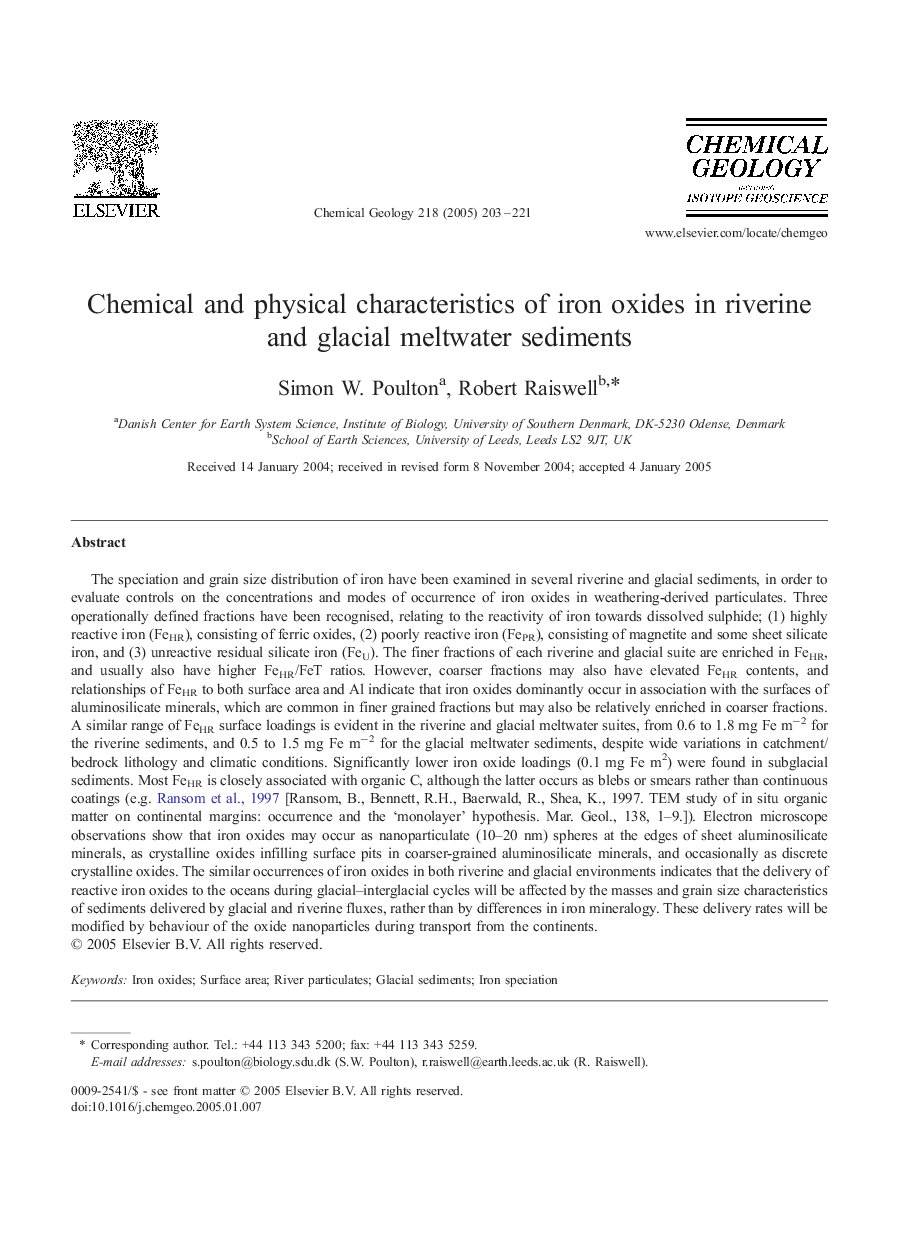| کد مقاله | کد نشریه | سال انتشار | مقاله انگلیسی | نسخه تمام متن |
|---|---|---|---|---|
| 9529017 | 1637787 | 2005 | 19 صفحه PDF | دانلود رایگان |
عنوان انگلیسی مقاله ISI
Chemical and physical characteristics of iron oxides in riverine and glacial meltwater sediments
دانلود مقاله + سفارش ترجمه
دانلود مقاله ISI انگلیسی
رایگان برای ایرانیان
کلمات کلیدی
موضوعات مرتبط
مهندسی و علوم پایه
علوم زمین و سیارات
ژئوشیمی و پترولوژی
پیش نمایش صفحه اول مقاله

چکیده انگلیسی
The speciation and grain size distribution of iron have been examined in several riverine and glacial sediments, in order to evaluate controls on the concentrations and modes of occurrence of iron oxides in weathering-derived particulates. Three operationally defined fractions have been recognised, relating to the reactivity of iron towards dissolved sulphide; (1) highly reactive iron (FeHR), consisting of ferric oxides, (2) poorly reactive iron (FePR), consisting of magnetite and some sheet silicate iron, and (3) unreactive residual silicate iron (FeU). The finer fractions of each riverine and glacial suite are enriched in FeHR, and usually also have higher FeHR/FeT ratios. However, coarser fractions may also have elevated FeHR contents, and relationships of FeHR to both surface area and Al indicate that iron oxides dominantly occur in association with the surfaces of aluminosilicate minerals, which are common in finer grained fractions but may also be relatively enriched in coarser fractions. A similar range of FeHR surface loadings is evident in the riverine and glacial meltwater suites, from 0.6 to 1.8 mg Fe mâ2 for the riverine sediments, and 0.5 to 1.5 mg Fe mâ2 for the glacial meltwater sediments, despite wide variations in catchment/bedrock lithology and climatic conditions. Significantly lower iron oxide loadings (0.1 mg Fe m2) were found in subglacial sediments. Most FeHR is closely associated with organic C, although the latter occurs as blebs or smears rather than continuous coatings (e.g. Ransom et al., 1997 [Ransom, B., Bennett, R.H., Baerwald, R., Shea, K., 1997. TEM study of in situ organic matter on continental margins: occurrence and the 'monolayer' hypothesis. Mar. Geol., 138, 1-9.]). Electron microscope observations show that iron oxides may occur as nanoparticulate (10-20 nm) spheres at the edges of sheet aluminosilicate minerals, as crystalline oxides infilling surface pits in coarser-grained aluminosilicate minerals, and occasionally as discrete crystalline oxides. The similar occurrences of iron oxides in both riverine and glacial environments indicates that the delivery of reactive iron oxides to the oceans during glacial-interglacial cycles will be affected by the masses and grain size characteristics of sediments delivered by glacial and riverine fluxes, rather than by differences in iron mineralogy. These delivery rates will be modified by behaviour of the oxide nanoparticles during transport from the continents.
ناشر
Database: Elsevier - ScienceDirect (ساینس دایرکت)
Journal: Chemical Geology - Volume 218, Issues 3â4, 25 May 2005, Pages 203-221
Journal: Chemical Geology - Volume 218, Issues 3â4, 25 May 2005, Pages 203-221
نویسندگان
Simon W. Poulton, Robert Raiswell,